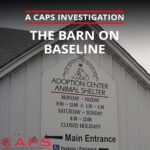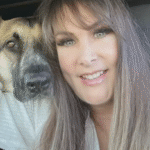Breeder: Beyer, Carol
Address: 2575 113th St.
City, State Zip: New Sharon, IA 50207
Year: 2006
USDA License: 42-A-0042
Date of CAPS Investigation: 2006-09-07
Time of CAPS Investigation: 13:15
On the premises at the time of investigation: approximately 35 dogs and 20 puppies.
Breeds: West Highland Terriers, Shih Tzus, Australian Shepherds, Yorkshire Terriers, Cairn Terriers, Jack Russell Terriers
Beyer’s kennel had an indoor whelping room and several rows of outdoor enclosures.
Outdoor enclosures
All of the outdoor enclosures were elevated on wooden stilts. They consisted of wire cages connected to wooden boxes via doggie doors. The wooden beams framing the cages had peeling white paint (3.1(c)(2)-Surfaces)..There was more than a week’s accumulation of feces under each cage, covered with flies (3.11(a)-Cleaning of primary enclosures); (3.11(d)-Pest control).
Two rows of these outdoor enclosures each consisted of three cages. Most of these pens housed two Australian Shepherds, one housed an Australian Shepherd and a Westie, and another housed a single Australian Shepherd puppy about three to four months old. Several of these cages had large gaps in the thick-gauge wire of their doors. In one, an Australian Shepherd had its head and neck completely outside the cage through a gap of the door (3.1(a)-Structure; construction).
This same row of cages had a variety of tools such as a garden hose and crowbars stored on top of its steel roof (3.1(b)-Condition and site).
There were about 12 smaller wire cages north of the Australian Shepherd structures. They were elevated with metal beams and also attached to wooden boxes. These cages each housed two smaller-breed dogs.
There was more than a week’s accumulation of feces under the cages, swarming with flies (3.11(a)-Cleaning of primary enclosures); (3.11(d)-Pest control). The doggie doors of these cages lacked windbreaks (3.4(b)(3)-Shelter from the elements), and the metal roof over the row had bricks and wooden poles on top of it to keep it in place (3.1(a)-Structure; construction).
All of the outdoor cages had metal or plastic water dishes with a dingy, brown build-up on their inner and outer surfaces. The boxes at the backs of the dog houses also had brown stains and build-up on the walls around the doggie doors (3.1(c)(3)-Surfaces).
Shooting “non-producing” dogs
This conversation took place regarding Mr. Beyer’s shooting his dogs:
Investigator: “If you decide to cull ’em, or if you have to put ’em down, do you have to have a vet come out and do that?”
Mr. Beyer: “You’re supposed to.”
Investigator: “Nobody knows if you just?”
Mr. Beyer: “Right.”
Investigator: “Yeah, okay.”
Mr. Beyer: “I’ve never had a vet put one of my dogs down yet, so.”
Investigator: “Okay, yeah.”
Mr. Beyer: “You’re supposed to have a plan, and depending on the DHIA guy, uh, USDA guy that comes out and talks to you. Like he told my wife. He says, ‘I don’t want to hear that you’re gonna shoot ’em. You gotta have a plan. You know? And the plan is to have a vet come out and put them down. That’s the plan. But it never happens. So every year we have to cull some dogs, some of the older ones, some are non-producing. And as much as you hate to do it, I try to find homes for ’em. A lot of times these dogs are just like two to three years old…”
Investigator: “But you know what? Shooting a dog isn’t exactly inhumane.”
Mr. Beyer: “Right. Right. I’m really particular, you know if they’re still moving. I’ll shoot ’em three times just to make sure they’re dead dead. And there’s no pain. And usually that first time. And be really careful that first time that you don’t miss. It’s humane as any way that there is, it’s just more violent than what a lot of people wanna hear about.” (2.40-Vet care)
Whelping building
The whelping building appeared to be used exclusively for the smaller dogs. It contained five stacks of whelping cages containing expecting or nursing mothers with puppies. Each stack consisted of two cages, one on top of the other, with plastic trays underneath the floorings to catch feces and debris. Plastic self-feeders were attached to the walls, and plastic water dishes were on the treated-wire floorings.




